Instructions for Side by Side Printing
- Print the notecards
- Fold each page in half along the solid vertical line
- Cut out the notecards by cutting along each horizontal dotted line
- Optional: Glue, tape or staple the ends of each notecard together
The Digestive System
front 1 The mechanical and chemical receptors that control digestive activity are located | back 1 in the walls of the tract organs |
front 2 The function of the hepatic portal circulation is to | back 2 collect absorbed nutrients for metabolic processing or storage |
front 3 The chemical and mechanical processes of food breakdown are called | back 3 digestion |
front 4 When we ingest large molecules such as lipids, carbohydrates, and proteins, they must undergo catabolic reactions whereby enzymes split these molecules. The series of reactions is called | back 4 chemical digestion |
front 5 The sheets of peritoneal membrane that hold the digestive tract in place are called | back 5 mesenteries |
front 6 From the esophagus to the anal canal, the walls of every organ of the alimentary canal are made up of the same four basic layers. arrange them in order from the lumen | back 6 Mucosa, submucosa, muscularis externa, and serosa |
front 7 Which of the following is not a factor that helps create the stomach mucosal barrier? | back 7 rennin |
front 8 What part of the tooth bears the force of chewing? | back 8 enamel |
front 9 The capillaries that nourish the epithelium and absorbs digested nutrients lie in the | back 9 lamina propria |
front 10 Which hormone causes an increased output of enzyme-rich pancreatic juice and stimulates gallbladder contraction to release bile? | back 10 cholecystokinin |
front 11 choose the incorrect statement regarding bile | back 11 Bile contains enzymes for digestion |
front 12 The absorptive effectiveness of the small intestine is enhanced by increasing the surface area of the mucosal lining. Which of the following accomplish this task? | back 12 plicae circulares and intestinal villi |
front 13 Select the statement that is true concerning primary teeth | back 13 there are 20 primary teeth, and by 24 months of age most children have all 20 |
front 14 Which of the following is true concerning the number and type of permanent teeth? | back 14 There are 32 permanent teeth, and the wisdom teeth are the last to emerge |
front 15 Which of the following is not true of saliva? | back 15 contains enzymes that begin the breakdown of proteins |
front 16 The salivary glands are composed of which two types of secretory cells | back 16 serous cells and mucous cells |
front 17 the solutes contained in saliva include | back 17 electrolytes, digestive enzyme, mucin, lysozyme, wastes, and IgA |
front 18 In addition to storage and mechanical breakdown of food, the stomach | back 18 initiates protein digestion and denatures proteins |
front 19 chyme is created in the | back 19 stomach |
front 20 hydrochloric acid is secreted by which of the secretory cells of the stomach | back 20 parietal cells |
front 21 Gastrin, histamine, endorphins, serotonin, cholecystokinin, and somatostatin are hormones or paracrines that are released directly into the lamina propria. Which of the following cell types synthesize and secrete these products | back 21 enteroendocrine cells |
front 22 these are three phases of gastric secretion. The cephalic phase occurs | back 22 before food enters the stomach and is triggered by aroma, sight, or thought |
front 23 peristaltic waves are | back 23 waves of muscular contractions that propel contents from one point to another |
front 24 Gastrin is digestive hormone that is responsible for the stimulation of acid secretions in the stomach. These secretions are stimulate by the presence of | back 24 protein and peptide fragments |
front 25 pepsinogen, a digestive enzyme, is secreted by the | back 25 chief cells of the stomach |
front 26 You have just eaten a meal high in complex carbohydrates. Which of the following enzymes will help to digest the meal | back 26 amylase |
front 27 the ducts that deliver bile and pancreatic juice from the liver and pancreas, respectively, unite to form the | back 27 hepatopancreatic ampulla |
front 28 the enzymatic breakdown of any type of food molecule is called | back 28 hydrolysis |
front 29 Short-chain triglycerides found infoods such as butterfat molecules in milk are split by a specific enzyme in preparation for absorption. Which of the following enzymes is responsible? | back 29 lipase |
front 30 parietal cells of the stomach produce | back 30 hydrochloric acid |
front 31 hepatocytes do not | back 31 produce digestive enzymes |
front 32 which of the following is not a phase of gastric secretion | back 32 enterogastric |
front 33 which vitamin requires intrinsic factor in order to be absorbed | back 33 B12 |
front 34 chief cells | back 34 are found in the basal regions of the gastric glands |
front 35 Chemical digestion reduces large complex molecules to simpler compounds by the process of | back 35 catabolism |
front 36 The___ contains lobules with sinusoids (lined with macrophages) that lead to a central venous structure | back 36 liver |
front 37 If an incision has to be made in the small intestine to remove an obstruction, the first layer of tissue to be cut is the | back 37 serosa |
front 38 The terminal portion of the small intestine is known as the | back 38 ileum |
front 39 The dental formula for an adult is 2-1-2-3- what does the 1 stand for? | back 39 canine tooth |
front 40 Digestion of which of the following would be affected the most if the liver were severely damaged | back 40 lipids |
front 41 ___ is locally regulated in the blood by the active from the vitamin D, which acts as a cofactor | back 41 calcium |
front 42 Important peritoneal folds do not include the | back 42 round ligament |
front 43 The lamina propria is composed of | back 43 loose connective tissue |
front 44 _____ is not important as a stimulus in the gastric phase of gastric secretion | back 44 carbohydrates |
front 45 Pancreatic amylase does not get to the small intestine via the | back 45 cystic duct |
front 46 The function of the goblet cells is to | back 46 produce mucus that protects part of the digestive organs from the effects of powerful enzymes needed for food digestion |
front 47 Which of the following is an essential role played by large intestine bacteria? | back 47 synthesize vitamin K and B-complex vitamins |
front 48 Nervous control of gastric secretion is provided by | back 48 the vagus nerve and enteric plexus |
front 49 Which of the following are types of papillae on the tongues that contain taste buds? | back 49 fungiform and circumvallate |
front 50 Which of the following produce intrinsic factor? | back 50 parietal cells |
front 51 Which of the following enzymes is specific for proteins | back 51 trypsin |
front 52 surgical cutting of the lingual frenulum would occur in which part of the body | back 52 tongue |
front 53 A fluid secreted into the small intestine during digestion that contains cholesterol, emulsification agents, and phospholipids is | back 53 bile |
front 54 The layer of the digestive tube that contains blood vessels, lymphatic nodes, and a rich supply of elastic fibers is the | back 54 submucosa |
front 55 which of the following is not characteristic of the large intestine | back 55 is longer than the small intestine |
front 56 what stomach secretion is necessary for normal hemoglobin production in RBCs? | back 56 intrinsic factor |
front 57 How are most nutrients absorbed through the mucosa of the intestinal villa | back 57 active transport driven directly or indirectly by metabolic energy |
front 58 Select the correct statement about the regulation of gastric secretion | back 58 gastric secretion can be stimulated before food has entered the mouth |
front 59 paneth cells | back 59 secrete enzymes that kill bacteria |
front 60 select the correct statement about digestive processes | back 60 chyme entering the duodenum can decrease gastric motility via the enterogastric reflex |
front 61 Chemical digestion in the small intestine involves | back 61 cholecystokinin (CCK), an intestinal hormones responsible for gallbladder contraction |
front 62 select the correct statement about absorption | back 62 if intact proteins are transported across the villus epithelium, an immune response may be the generated |
front 63 select the correct statement about electrolyte absorption | back 63 iron and calcium are absorbed mostly by the duodenum |
front 64 You have just eaten french fries, buttered toast, ice cream, and whole milk. Which of the following glands would be active in helping you to digest this food? | back 64 the pancreas |
front 65 The ingestion of the meal high in fat content would cause which of the following to occur? | back 65 Bile would be released from the gallbladder to emulsify the fat in the duodenum |
front 66 The mucosa of the developing alimentary tube comes from | back 66 endoderm |
front 67 A baby is admitted to the hospital with a history of projectile vomiting after each feeding. On examination, it is found that the sphincter controlling food passage from the stomach to the duodenum is thickened and does not open readily. Because of the baby's loss of gastric juice, his blood probably indicates | back 67 alkalosis |
front 68 Hormones or paracrines that inhibit gastric secretion include | back 68 secretin |
front 69 which of these not part of the splanchnic circulation | back 69 inferior vena cava |
front 70 What is the process of digestion | back 70 Ingestion propulsion mechanical breakdown digestion absorption defecation |
front 71 select the correct statement about absorption | back 71 if intact proteins are transported across the villus epithelium, an immune response may be generated |
front 72 alimentary canal | back 72 digests and absorbs food. mouth, pharynx, esophagus, stomach, small/large intestine |
front 73 accessory organs | back 73 teeth, tongue, gall bladder, salivary glands, liver, and pancreas. produce secretin that helps break down food |
front 74 layers of the alimentary canal | back 74 mucosa, submucosa, muscularis externa, serosa |
front 75 anatomy of the oral cavity | back 75 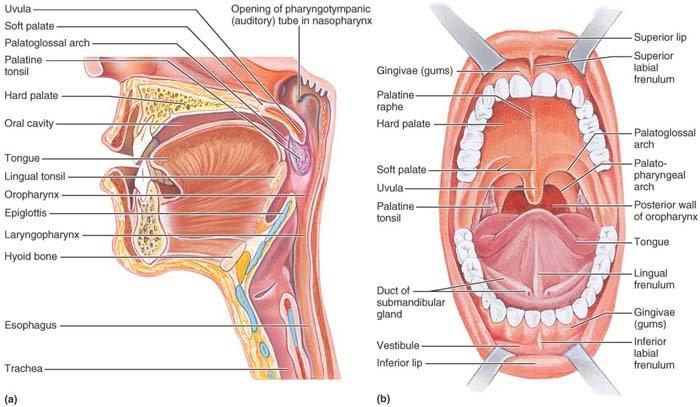 |
front 76 The tongue | back 76 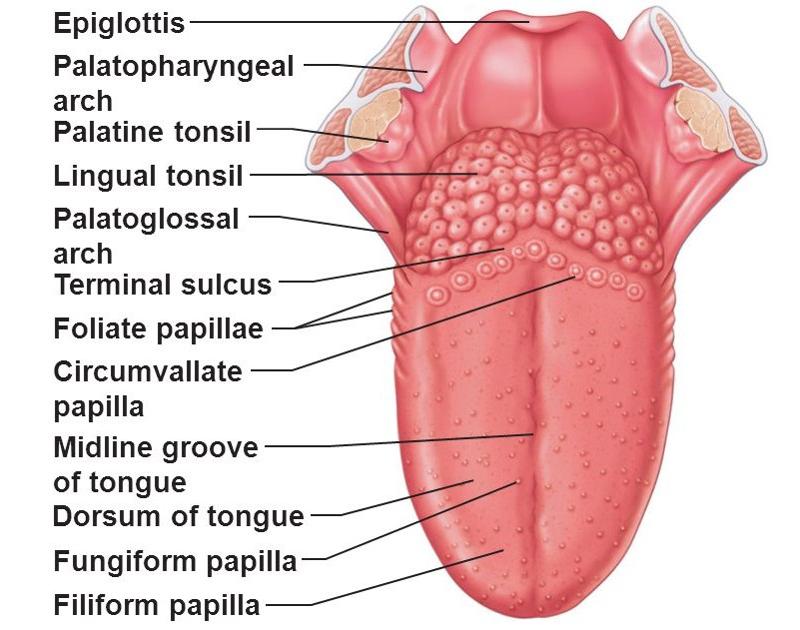 |
front 77 The salivary glands A. ducts of sublingual gland B. sublingual gland C. Parotid gland F. submandibular gland | back 77 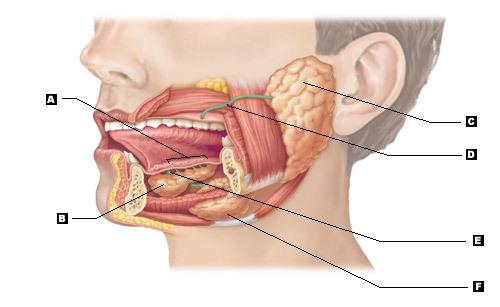 |
front 78 splanchnic circulation | back 78 includes arteries that branch off the abdominal aorta to serve the digestive organs and hepatic portal circulation |
front 79 intrinsic muscles | back 79 confined in tongue and not attached to bone allows tongue to change its shape |
front 80 extrinsic muscles | back 80 alters the tongue's position they protrude it, retract it, and move it from side to side |
front 81 lingual frenulum | back 81 secures the tongue to the floor of the mouth and limits its posterior movement. |
front 82 filiform papillae | back 82 roughen the tongue surface. provides friction for manipulating foods. |
front 83 enteric nervous system | back 83 the in-house nerve supply of alimentary canal. |
front 84 enteric neurons | back 84 communicate widely with one another to regulate digestive system activity |
front 85 peritoneum | back 85 most extensive serous membrane |
front 86 visceral peritoneum | back 86 covers external surfaces of most digestive organs |
front 87 parietal peritoneum | back 87 lines body walls |
front 88 peritoneal cavity | back 88 slit like space containing a slippery fluid secreted by serous membrane |
front 89 mesentery | back 89 double layer of peritoneum. Provides routes for blood vessels, lymphs, and nerves to reach digestive viscera holds organs in place stores fat |
front 90 function of The salivary gland | back 90 Cleanses the mouth dissolves food chemicals moistens food and helps compact it contains amylase that begins the digestion of starchy foods |
front 91 two types of secretory cells | back 91 serous and mucous cells |
front 92 cardiac sphincter | back 92 a physiological sphincter |
front 93 primary dentitions | back 93 upper jaw: 2 incisors, 1 canine, 2 molars/2 incisors, 1 canine, 2 molars X 2 20 teeths |
front 94 permanent dentition | back 94 2 incisors, 1 canine, 2 premolars, 3 molars/ 2 incisors 1 canine, 2 premolars, 3 molars X 2 32 teeths |
front 95 digestive processes of the mouth | back 95 the mouth ingests Begins mechanical breakdown by chewing intitiates propulsion by swallowing starts the digestion of polysaccharides |
front 96 The pharynx | back 96 food passes to the oropharynx, then to the laryngopharynx The mucosa contains stratified squamous epithelium |
front 97 the esophagus | back 97 esophageal hiatus: where it pierces the diaphragm cardiac orifice: where it joins the stomach |
front 98 anatomy of the stomach | back 98 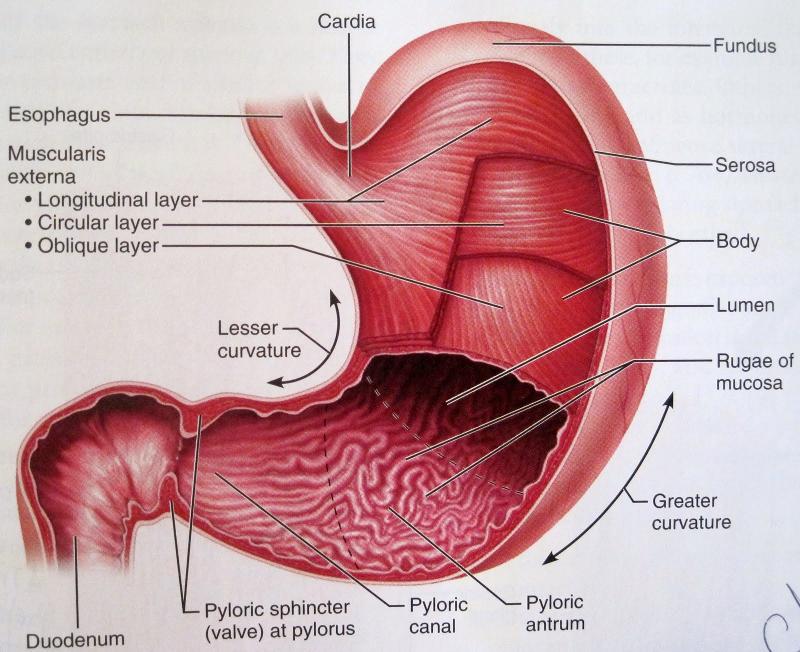 |
front 99 buccal phase of swallowing | back 99 occurs in the mouth; voluntary it ends when bolus leaves mouth and stimulates tactile receptors in the pharynx |
front 100 Pharyngeal-esophageal phase | back 100 involuntary. controlled by medulla and lower pons. vagus nerves transmit motor impulses from the swallowing center to the muscles of the pharynx and esophagus |
front 101 enterogastrones | back 101 secretes cholecytokinin (CCK) and secretin |
front 102 alkaline tide | back 102 as acid is pumped into the stomach, HCO3- is exported into the blood |
front 103 gastric glands | back 103 produce stomach secretion |
front 104 parietal cells | back 104 found in apical region of glands. secretes HCL and intrinsic factor |
front 105 pepsin | back 105 protein-digesting enzyme. activating of pepsin helps digest proteins, breakdown plant food and kills bacteria |
front 106 chief cells | back 106 occurs in basal regions of the gastric glands. produces pepsinogen |
front 107 cephalic phase of gastric secretion | back 107 occurs before food enters the stomach |
front 108 gastric phase | back 108 releases gastric juice. 3-4hrs longs occurs once food enters the mouth |
front 109 intestinal phase | back 109 occurs with a brief stimulatory component followed by inhibition |
front 110 enterogastric reflex | back 110 duodenum inhibits acid secretion through the enteric nervous system (short reflexes) and sympathetic and vagus nerves (long reflexes) |
front 111 Gross anatomy of the liver | back 111 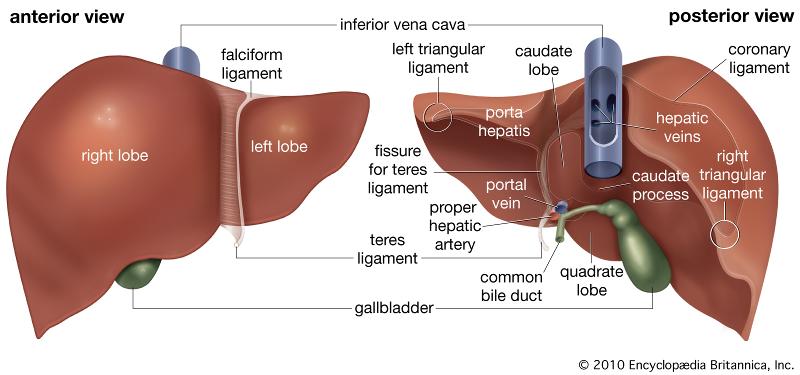 |
front 112 The Liver | back 112 produces bile for export to the duodenum bile breaks fat into tiny particles to make it digestible. bile leaves the liver through right and left hepatic ducts |
front 113 Bile | back 113 yellow-green, alkaline solution containing bile salts, bile pigments, cholesterol, triglycerides, phospholipids, and variety or electrolytes. |
front 114 Bile salts | back 114 primarily salts of cholic and chenodeoxycholic acids |
front 115 bilirubin | back 115 chief bile pigment. yellow waste product of the heme of hemoglobin formed during the breakdown of word out RBCs |
front 116 gall bladder | back 116 stores bile that is not needed for digestion covered by visceral peritoneum |
front 117 pancreas | back 117 produces enzymes that breakdown all foodstuffs |
front 118 pancreatic juices | back 118 proteases (protein) amylases (starch) lipase (fats) nucleases (nucleic acids) |
front 119 small intestine | back 119 3 sections duodenum (10 inches) jejunum (8ft) ileum (12ft) site for digestion and absorption |
front 120 enteropeptidase | back 120 within the duodenum activates trypsinogen to trypsin |
front 121 retroperitoneal organs | back 121 organs that loses their mesentery and lies posterior to the peritoneum |
front 122 intraperitoneal organs | back 122 organs that keeps their mesentery and remains in the peritoneal cavity |
front 123 gross anatomy of large intestine | back 123 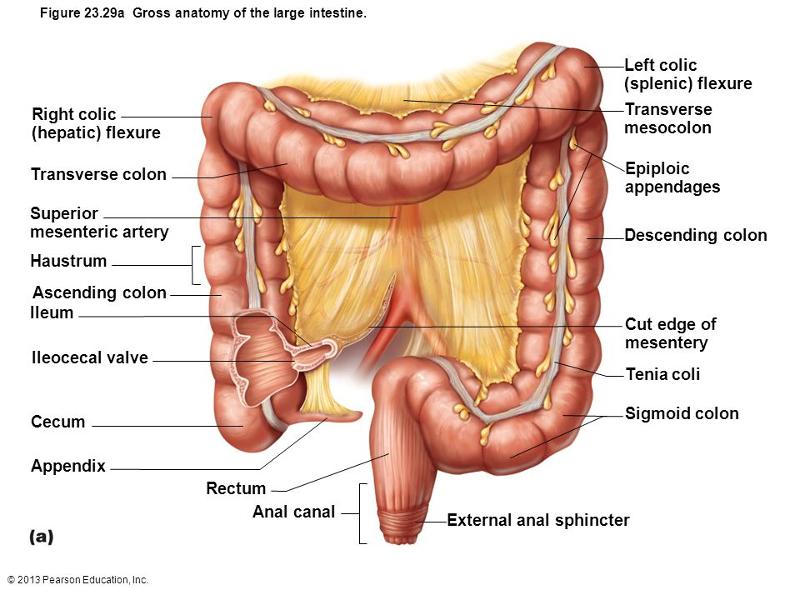 |